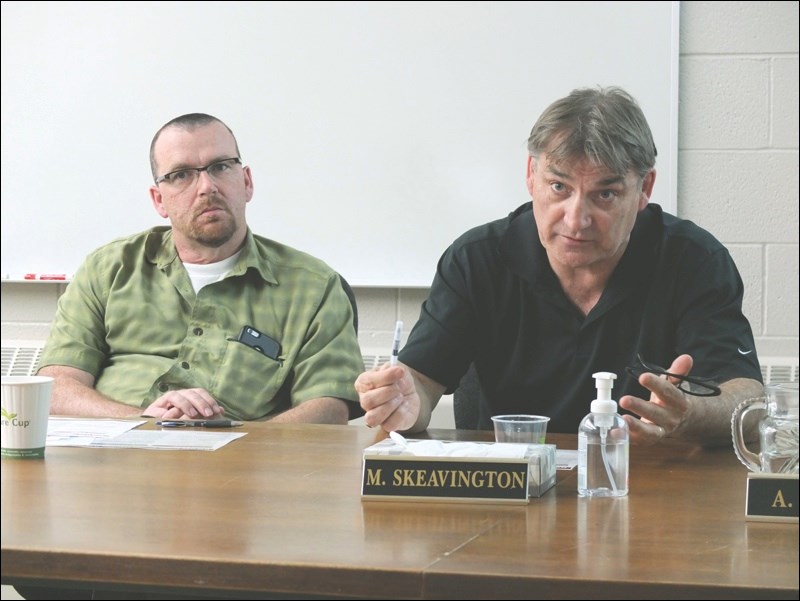Mental health figures prominently into the Flin Flon School Division’s new multi-year blueprint for stronger schools and more successful students.
In its 2016-19 strategic plan, unveiled Tuesday, the division focuses on three areas: academic success, student engagement and mental wellness.
For Trustee Murray Skeavington, chairman of the school board, the emphasis on mental wellness represents the biggest shift from the status quo.
“That’s a huge one for us,” he said.
Key to the new approach is the hiring of a mental wellness worker, Darcy Snyder, who will begin working at all four Flin Flon schools this September. Snyder will complement existing mental-health programming.
“We identified a gap in our services,” said Trustee Amy Sapergia Green. “We have school guidance counsellors who do play an excellent role in supporting [students], and I think they do a really great job looking at engagement, looking at bullying. And these are less serious mental difficulties and disorders.
“But when you’ve got kids who are struggling with serious problems, they’re often not equipped to handle it. The school psychologist has a role to play largely in diagnosing, but not necessarily in day-to-day function of that child. So I think that what we’re hoping is that having [Snyder] kind of in the middle to work with those people as well, we will catch kids that are maybe higher risk.”
Trustee Andy Burbidge said mental wellness came up often during discussions on the strategic plan.
“I’ve been watching the news and reading different papers, and you see them talking about this as an issue in many, many schools, both for staff and students,” he said. “So we want to support the school division [in promoting] mental wellbeing.”
The strategic plan lists a handful of broad goals related to mental wellness, including expanded partnerships with community organizations such as the Northern Health Region, education to reduce the stigma of mental illness, and ensuring fewer students are suspended over mental wellness issues.
Engagement
The plan also emphasizes student engagement by promoting social and academic success at all levels, developing a strategy to support the enrichment of both struggling and gifted students, and bolstering aboriginal student engagement.
On the latter point, the blueprint sets out to incorporate aboriginal themes and content into classroom learning, maintain aboriginal graduation rates that are at or above the provincial average, better engage the aboriginal community and provide resources for staff in the area of aboriginal education.
The plan further envisions a hiring protocol that better reflects student demographics, which could mean more aboriginal employees. Skeavington said the division would also like to hire more male teachers, but they are hard to come by.
Academics
Academic success is the third and final plank in the strategic plan. The focus is on success in literacy and numeracy, proper use of resources to support special-ed students, and an expanded vocational-ed and non-traditional trades program.
Under the plan, school administrators will explore how to integrate trades and tech education at the grades 1 to 6 level. Sapergia Green said this will involve looking at measures that have been successful for other divisions.
“Obviously it would be important to look at what’s developmentally appropriate,” she said. “So are we going to take the grade 1s to go build a house? Of course not, right? But maybe there is something that they can do with an older grade, or maybe there is something that another division has implemented that is just really wonderful and a really great introduction to a trade or a vocational education. And it’s really just about us figuring those things out right now.”
Skeavington said the hope is that students can eventually begin trades courses in grade 9 and graduate four years later with a level 1 certificate.
“Some of these vocational opportunities are going to be driven by the kids,” he added. “We can say we’re going to offer a welding course and have kids say, ‘Well, we don’t want to learn welding.’ So why would you offer the course if no one’s going to show up? You’ve got to see what the kids also want.”
Though the issue was not directly addressed in a summary of the strategic plan distributed by the board, Skeavington said the division will continue to work with students who are of school age but are not consistently in the classroom.
The division has estimated there are about 60 such students, but Skeavington said some of them are transient and it’s not clear how many are still in
Flin Flon.
He said there are ongoing efforts to keep track of those students and that the division employs a student engagement worker, Leanne Phair, to try and get them to return to school.
As the strategic plan is implemented, Burbidge said, data will be collected to identify any gaps. Steps would then be taken to bridge those gaps.
Consultation
Trustees developed the strategic plan in consultation with the public. While the blueprint is a board-driven initiative, the specific goals will be implemented by the schools.
Burbidge said the plan was borne out of the initiation process he and trustees Sapergia Green and Leslie Fernandes went through after joining the board in 2014.
He said the board learned the division was a rarity in that it did not have a multi-year plan on the books. Trustees then agreed to formulate such a document.
An official from the Manitoba School Boards Association visited Flin Flon to meet with the trustees and assist them in developing the plan.
“At the end of the day, after much, much, much work, this is what came out of it,” said Burbidge, referring to the strategy unveiled Tuesday at the board office.
Public interest in the plan appeared low, with only three people – two of them reporters – attending Tuesday’s public presentation.
A copy of the plan was scheduled to be uploaded to the school division website (www.ffsd.mb.ca) this week.




